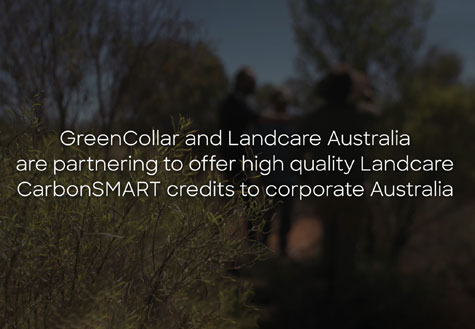Holistic solutions to reduce your environmental footprint
Nature-based solutions that help you contribute where it matters
GreenCollar is the largest environmental markets project developer and investor in Australia. We provide around 50% of all the vegetation-based Australian Carbon Credit Units (ACCUs) to market and are leading the way in developing new solutions such as Reef Credits to address water quality, NaturePlus™ Credits to tackle biodiversity loss, and Plastic Credits to actively reduce the impact of single-use plastics on the environment.
Our own portfolio of over 200 high quality, high integrity, and high impact projects are delivered in partnership with farmers, graziers, Traditional Owners and other land managers around Australia. We also work overseas, developing a range of environmental projects across carbon, water, plastics and nature that are designed make a difference where it matters.
We understand what it takes to maintain quality, integrity and credibility in environmental action, working with Australia’s most recognisable brands and institutions to develop impact reduction and offset purchasing strategies that facilitate new product development and deliver on their Environmental, Social, Governance (ESG) and net zero strategies.
We have a large and diverse network of projects and suppliers across the globe that allow us unrivalled access to high quality, high integrity international credits. We hold our suppliers to the same high standards and quality of outcome as our own projects, leveraging our unique, robust, and proprietary due diligence framework to ensure our international credit portfolios are of the highest standard.
When purchasing environmental credits, quality is crucial
Not all environmental credits are created equal, so when it comes to purchasing as part of a broader sustainability strategy, quality is important. Our portfolio of projects are stacked with additional value to create environmental solutions that not only mitigate climate impact but also tackle biodiversity conservation, soil rehabilitation, and invasive species management, as well as delivering community benefits and improving water-quality.
The quality of the credit is determined by the source and nature of the project on the ground. Our Australian projects, and the international projects we source from, are meticulously designed to provide a range of environmental, social, community and economic benefits beyond just climate mitigation.
Our environmental credit solutions


Carbon farming projects that regenerate and protect native vegetation to store carbon in growing vegetation and prevent the release of emissions through land clearing or wildfires.


Reef Credits improve water quality at the Great Barrier Reef by delivering measured reductions in nutrient or sediment entering waterways within Reef catchments.


NaturePlus™ is a world-first biodiversity credit scheme
that delivers measured and verified restoration or conservation of important ecosystems.


Operating under Verra’s Plastic Waste Reduction Standard, our world-leading Plastic Credit projects remove single use plastics from the environment and create pathways to increase recycling.
Frequently asked questions
Over 100 million tonnes of CO2 has been reduced through Australia’s national carbon offset market–a proven, measurable way to lower the amount of carbon and other greenhouse gases in the atmosphere. The carbon market is seeing governments, businesses and individuals invest in increasingly large numbers—with Australian Carbon Credit Unit (ACCU) prices projected to double by 2030.
So how exactly does this lucrative, fast-growing market work?
What is a carbon market?
Carbon markets reduce greenhouse gas emissions through the purchase and trade of offsets produced by carbon reducing activities. Through the participation of governments, companies and individuals investing in environmental and carbon reduction projects, carbon markets work to balance out or ‘offset’ any unavoidable emissions in their value chains. The above describes voluntary carbon markets, where companies and individuals invest by choice to reduce their carbon footprint and enhance their ESG and net zero credentials. There are also compliance markets, where large emitters are obligated to purchase credits if their emissions exceed the cap set by the market regulator. The Clean Energy Regulator’s (CER) Safeguard Mechanism is an example of a compliance market.
What's an ACCU and how does it work?
ACCU stands for Australian Carbon Credit Unit. One ACCU represents one tonne of carbon dioxide equivalent sequestered(stored) or avoided by a project. Australian Carbon Credit Units (ACCUs) are issued by the Clean Energy Regulator (CER) to value greenhouse gas abatement activities undertaken as part of the Australian Government’s Emissions Reduction Fund. The CER is an independent statutory authority established by the Australian Government, and the issuance of ACCUs is governed by the CFI Act 2011, the Carbon Credits Regulations 2011 (Carbon Farming Initiative Regulations 2011), and the Carbon Farming Initiative Rule 2015 (CFI Rule 2015).
A whole lot of regulatory requirements must be satisfied before a project can be declared an ‘eligible offsets project’, and on top of that, we’ve got the highest standards in terms of how our outcomes are governed, measured, managed, audited and verified.
- Each project is subject to robust scientific measurement and must have an approved methodology
- It must deliver positive environmental outcomes that wouldn’t happen naturally, without any negative environmental or social side-effects
- It must comply with strict eligibility requirements, including third party auditing and governance
- GreenCollar, as the organisation responsible for the project must report to the CER about progress and abatement achieved
Like other commodities (eg gold, wheat, copper, cotton etc) ACCUs can be bought and sold in the secondary market. The price of an ACCU is driven by supply and demand so as demand for ACCUs increases, prices go up. Prices are also reflective of the quality and integrity of the projects that generate an ACCU. For example, the ACCUs we buy are generated by nature-based projects that deliver additional benefits such as improvements in natural habitat and biodiversity so they are priced at a premium.
How does trading occur under the Emissions Reduction Fund?
The process works somewhat like a tender process. Eligible carbon reduction projects bid for a contract to sell their ACCUs to the CER, who run auctions to match buyers (the Federal Government) with sellers (project developers) . A primary objective of the CER is to select projects that offer the largest amount of carbon reductions for the least amount of funding. This maximises the amount of taxpayer-funded offsetting that can be achieved.
How does trading occur under the voluntary market?
Once issued ACCUs can be traded within the voluntary market and sold to individuals, Governments or corporates that want to offset their own emissions. An ACCU must be surrendered to count towards emission reduction targets. When surrendered, ACCUs are retired from the market and are not available for resale. By choosing to offset your emissions, you are choosing to purchase and retire ACCUs and are therefore making a quantifiable difference to the amount of CO2 in the atmosphere.
Why invest in the carbon market?
Like other commodities (eg gold, wheat, copper, cotton etc) ACCUs can be bought and sold in the secondary market. The price of an ACCU is driven by supply and demand so as demand for ACCUs increases, prices go up. Prices are also reflective of the quality., impact and integrity of the projects that generate an ACCU. For example, our ACCUs are generated by nature-based projects that deliver additional benefits such as improvements in natural habitat and biodiversity, so they are priced at a premium.
But carbon market investment is about more than direct financial returns, it is a crucial brand investment. One Fifth of the world’s 2000 largest companies are already committed to carbon net zero targets and links between strong ESG principles and share market performance have proved to be far more than incidental. One study by Nordea Equity Research found that companies with the highest ESG ratings outperform those with the lowest ratings by up to 40%.
How is GreenCollar involved in the carbon market?
GreenCollar is the largest project developer in the Australian carbon market with over 200+ projects covering over 10 million hectares and generating 125+ million Australian Carbon Credit Units (ACCUs). ACCUs are generated from avoiding clearing of native vegetation or regrowth of native vegetation in regional Australia.
On every project, GreenCollar partners with land managers and Indigenous custodians who employ land and fire management strategies on-farm and on-Country, to reduce or actively absorb carbon and other greenhouse gases. As well as our work with project developers, GreenCollar uses extensive market knowledge to lead industry research programs and assist in the pioneering of other new environmental markets, such as the Reef Credit and plastics credit schemes.
How can investors get involved in the carbon market?
Participation in the Australian carbon market is relatively simple and can be achieved by contacting project developers such as GreenCollar,. GreenCollar has a wealth of expertise on facilitating quality carbon reduction projects and maximising investment returns. We work with land managers, Indigenous groups and Natural Resource Management organisations to develop high-value, high-integrity, high impact projects that offer comprehensive ESG benefits for investors.
What to be aware of when purchasing carbon offsets?
A key risk when purchasing offsets from carbon projects is that the project fails to deliver quality, impactful and integrable climate solutions, impacting the credibility of the participating company’s brand and reputation. But while these low-quality products are available, industry transparency is growing, and regulation surrounding carbon farming nature-based project eligibility is robust. Companies choosing to meet ‘net zero’ targets with low-quality offsets are being increasingly exposed as quality and transparency improve within the industry, reducing the opportunity for greenwashing. Likewise, for companies seeking ‘net zero’ status, there is a verification process that may be adhered to. Climate Active’s Carbon Neutral Standard (CACNS)—previously NCOS—ascertains the credibility of carbon neutrality claims made by public and private enterprises. Though currently a voluntary standard, the consideration given to the quality of carbon offsetting programs and projects is becoming more important as the carbon market continues to grow. This quality verification will likely increase as the importance of transparency, integrity, impact and quality increases .
Is carbon trading a credible solution to climate change?
While ESG benefits to investors are important, the core objective of carbon markets is to actually quantify and reduce the carbon dioxide that is being emitted into the atmosphere. The CER estimated last year that over 100 million tonnes of CO2 have been abated through Australian carbon farming projects under the ERF. The Clean Energy Regulator’s Australian carbon market scheme is supported by a raft of measures to ensure continued integrity of the Emissions Reduction Fund . GreenCollar’s own projects are developed to deliver a suite of environmental outcomes in a single project. These benefits include preservation of vulnerable habitat, biodiversity enhancement, significant improvements to water and soil quality as well as emissions reduction.
Why work with GreenCollar
We put the environment on the balance sheet
With over 13 years in the industry pioneering new ways to finance environmental progress, it’s our mission to put nature on the balance sheet. We work alongside the country’s leading corporates, land managers, research and environmental organisations to accelerate the transition to a net zero world and drive positive impact at scale.
Leaders in the industry
GreenCollar is a profit-for-purpose organisation, and the leading environmental markets project developer and investor across the carbon, water quality, biodiversity and plastics markets in Australia. We work with farmers, graziers, Traditional Owners and other land managers throughout Australia and overseas, to develop projects that create commercial opportunities by generating environmental credits, while caring for the environment.
An environmental markets company with global reach
Not only do we develop high quality, high integrity nature-based projects that deliver multiple benefits here in Australia, we are also working to establish projects and initiatives on an international scale. We are facilitating partners in the Peoples Forest Partnership, an initiative that aims to direct more global investment to Indigenous Peoples, Traditional Owners, and local communities who act as forest guardians, rewarding their efforts to successfully stop deforestation. We also have a large and diverse network of projects and suppliers across the globe that allow us unrivalled access to high quality, high integrity and high impact international credits.
End-to-end carbon market services
With over 200 nature-based projects generating over 126 million credits, we are the largest provider of ACCUs in the Australian market. We work with global businesses to develop emission reduction and offset purchasing strategies to achieve net zero targets.
A trusted business partner
As the leader in the Australian carbon market, we can work with you to meet your carbon offset goals and provide you with the latest carbon market and policy updates to help you get there. We are grounded in science and research. We don’t cut corners or compromise on quality–we hold ourselves accountable and deliver to our promises.
Thought leaders in the carbon industry
GreenCollar’s management team was fundamental in helping to establish Australia’s carbon market framework and are widely recognised as thought leaders in the carbon markets industry. You can have confidence knowing that the projects we run and the carbon, reef, plastic and nature credits they generate are best practice.
Enquire today
Get in touch to discuss our high quality, high integrity and high impact environmental credits.







